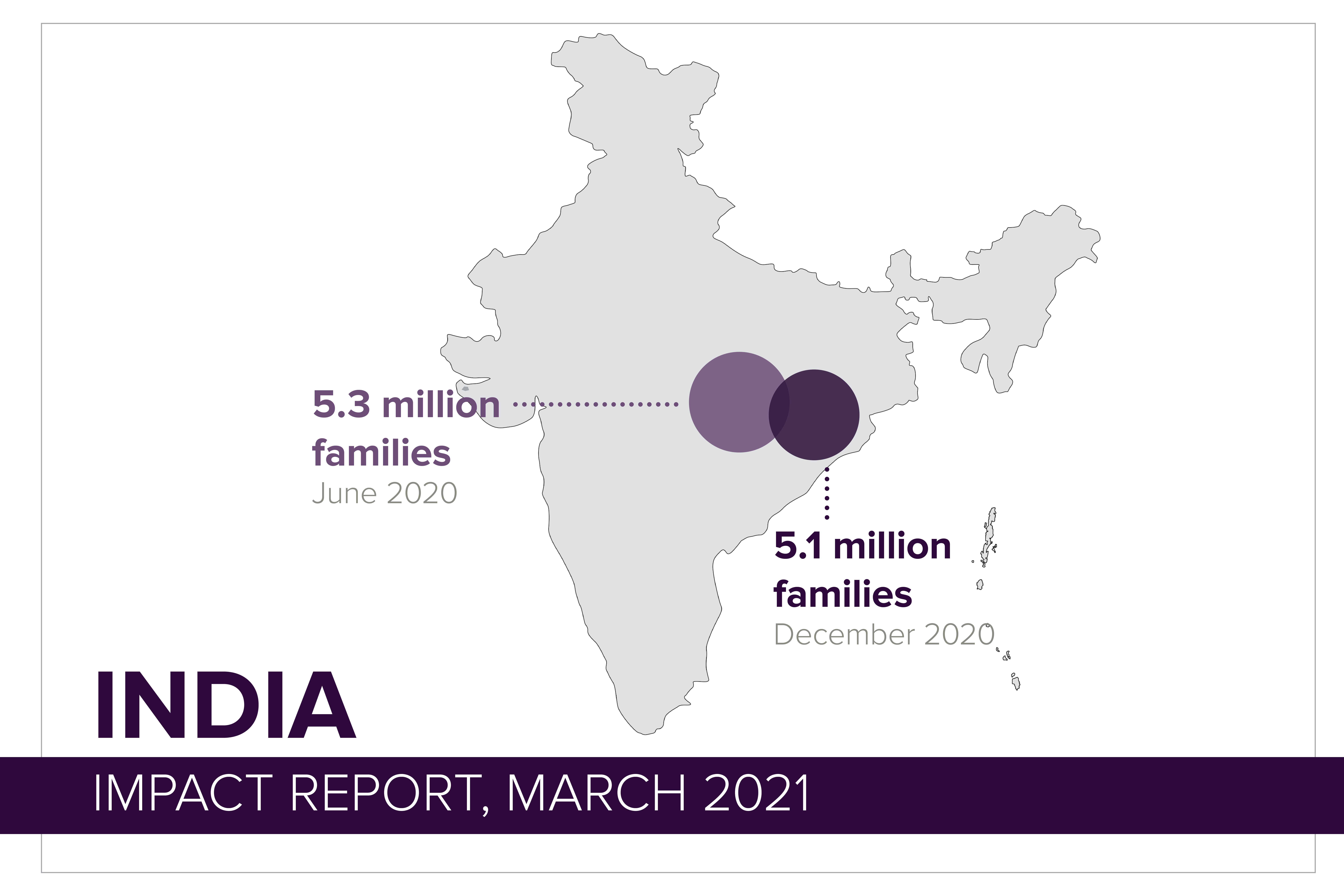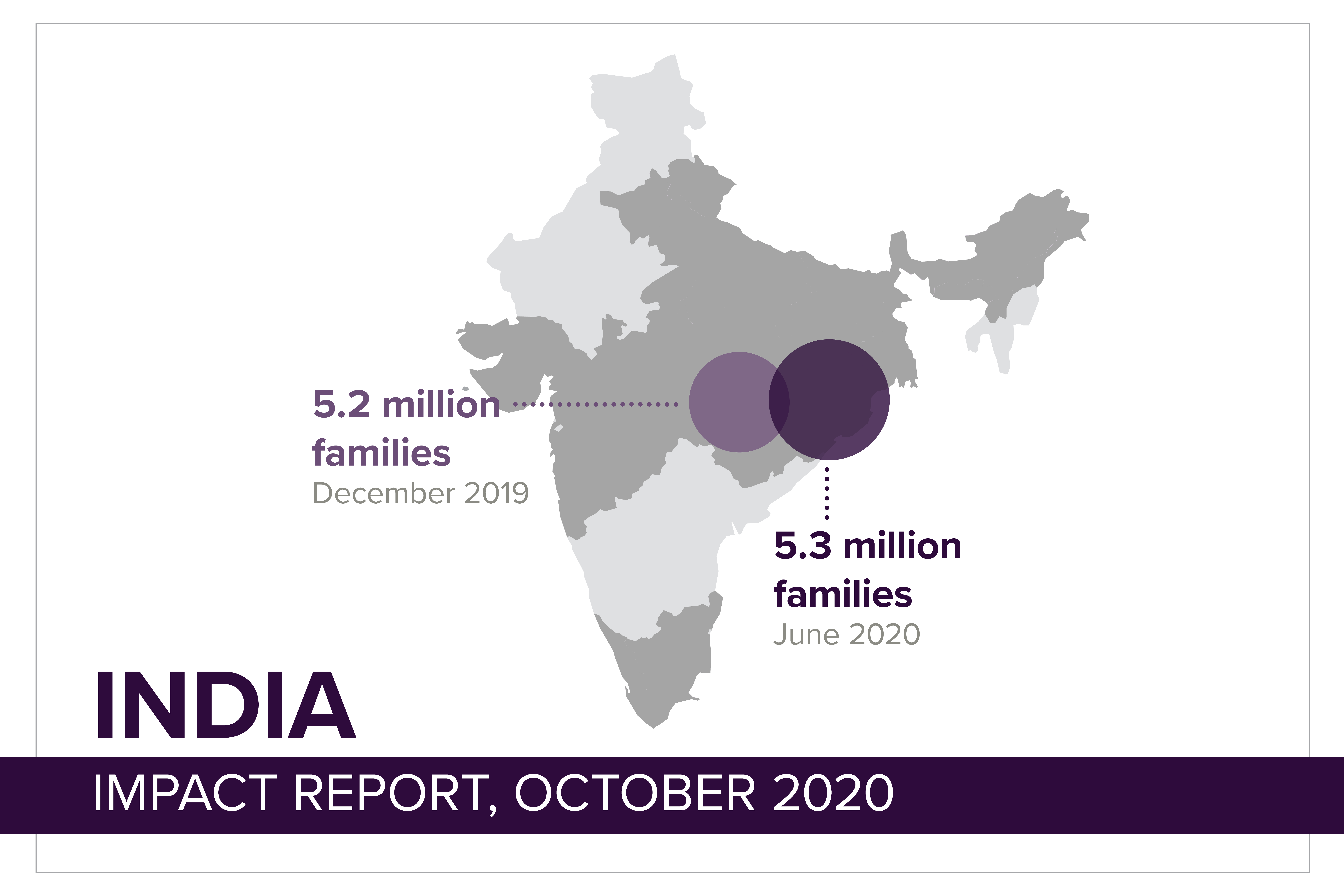Data to December 2020
*Understand portfolio at risk and operational sustainability
Pravati's story
Microloans and beyond
When Pravati heard about Opportunity’s microfinance partner Satya from one of her relatives, she was attracted by the possibility of a loan to set up her own business. Living in the small village of Samipur, Odisha, in eastern India, Pravati didn’t have access to formal sources of finance. After attending a meeting held by Satya on the financial services that were available, she took out a loan of INR35,000 (A$620) to set up a snack stall selling sweets and food to increase her income and savings.
When the COVID-19 pandemic hit in March 2020 and India went into strict lockdown to prevent the virus’ spread, Pravati was forced to close her shop. When she reopened, it was to far fewer customers and sales; she was forced to use her savings to cover her basic living expenses. Then her son Bhagaban fell ill and needed to be hospitalised. With her savings depleted, she feared the cost of treatment would plunge her family deeper into poverty, or worse, that they would not be able to pay for the health care Bhagaban so desperately needed.
At the outset of the pandemic, Satya had seen the need for a health insurance product to protect vulnerable families from the catastrophic economic impact of ill health and high health care costs. Research encompassing 35,000 interviews with people in five different countries (including India) shows that ‘ill health – when high treatment costs go together with loss of earning power – imposes a double burden on households and it has the biggest influence on becoming poor (and remaining poor).’1
To protect women like Pravati from being returned to poverty, Satya developed ‘Care Health Insurance’ which covered Pravati, as a microfinance client, along with her family members, for hospital treatment for any critical illness up to a cost of INR100,000 (A$1,775) in a two-year period.
As an existing Satya client, Pravati was offered the health insurance free of charge. Her loan officer put her in contact with the health insurance officer who walked Pravati through the process of gathering the necessary documents for hospital admission and making a claim. Bhagaban was able to get the treatment he needed at a reputable hospital. Thanks to this experience Pravati knows ‘that a very good team is behind us to provide support in our hard times’.
Area of focus
The microfinance sector in India has experienced events that have significantly impacted their operations in the past 10 years, including the 2010 Andhra Pradesh (AP) Amendment Bill which curtailed microlending activities in that state and impacted operations and repayment practices across the country, demonetisation of two commonly used banknotes in 2016 that led to prolonged cash shortages, and most recently the COVID-19 pandemic.
In each case, the impacts were severe and far reaching for the microfinance institutions (MFIs) and non-banking financial companies (NBFCs) that provide people living in poverty with financial services that allow them to earn an income to meet the needs of their families.
Many of the government-imposed lockdowns that began in late March 2020 to halt the spread of coronavirus were progressively relaxed from June to December 2020 but lockdowns remain in place into 2021 in some states. The impact of restrictions on economic activity has been severe on microbusiness owners, particularly those in the informal sector who rely on trading and have few resources to cushion the impact of any crisis.
Due to the economic fallout from COVID-19 restrictions, the Reserve Bank of India (RBI) directed MFIs/NBFCs to provide repayment moratoriums to all borrowers initially from March to June 2020, which was then extended to certain borrowers out until December 2020. This created a serious disruption to loan repayment collections and consequently to the financial sustainability of those of Opportunity’s partners, especially the small and medium-sized MFIs. The full financial impact of the moratorium period is not yet known as many loans have been restructured and the calculation of portfolio at risk (PAR) clouded by delayed repayment due dates.
Despite the strain on cashflow presented by the moratoriums and lack of economic activity and repayment capability, each of our partners, in line with their mission to support those living in poverty, provided direct support to their clients.
This support included health education to reinforce the importance of hygiene, disinfectants and social distancing in reducing the risk of the disease spreading, supplying disinfectants, face masks and soap, and, in those hardest hit areas, emergency food supplies.
It is expected that as COVID-related restrictions ease and economic recovery begins, there will be greater demand for loans from Opportunity’s partners. They are working to secure lender funding for lines of credit so that they will be able to provide recovery loans to people living in poverty. However, many equity investors have become cautious in the current uncertain climate, some putting pre-pandemic investment plans on hold, making it difficult for Opportunity’s smaller partners to raise fresh loans from banks and financial institutions.
COVID-19 has also renewed the focus of Opportunity’s partners on digitising operations both at client and back office levels. Various digital repayment collection systems are being explored including apps, biometric-enabled payment systems, QR codes and mobile payments.

Partner performance
In the second half of 2020, Opportunity changed its arrangements with two financial institutions in India and as a result, their performance indicators are not included in this report. From time to time, Opportunity’s portfolio of partners changes as partners are added and others disengage. The reasons for disengagement with partners are various and include when partners mature enough to no longer require financial or other support from Opportunity, their structure is incompatible with continued funding from us, or there is a departure from an alignment with our mission.
Of the nine partners listed in the table below, number of families reached overall grew by 104,905. For larger partners with over 300,000 microfinance clients, the number of active borrowers grew by 125,389 in the second half of 2020. More moderate growth in outreach of 31,191 was experienced by the medium-sized financial institutions (between 100,00 and 300,000 clients). The smaller partners (<100,000 clients) contracted by 15,675 clients.
After the end of the repayment moratorium period (March-December 2020 in some instances) imposed by the Reserve Bank of India (RBI) to protect borrowers during the COVID lockdown, Opportunity’s non-banking microfinance partners in India reported rising portfolio at risk (PAR)3, reflecting increased defaults when rescheduled loans fell due. The Small Finance Banks (ESAF and NESFB) are required by the RBI to report non-performing assets (NPA)5 which is a more stringent measure of performance than PAR, and showed 10 per cent of outstanding loans were not yielding any income in the form of interest payments by 31 December 2020.
India Microfinance Partner Summary
|
|
Families Reached |
Loans Outstanding A$'000 |
Operational Sustainability3 |
|---|---|---|---|
|
ESAF |
2,865,838 | $1,656,971 | 116% |
| CASHPOR SATYA PAHAL |
1,729,995 | $826 787 | 113% |
| MARGDARSHAK ADHIKAR |
393,355 | $100,845 | 106% |
| GO FINANCE ANNAPURNA |
141,861 | $62,130 | 135% |
| Overall | 5,331,5902 | $2,646,733 | 115% |
Operational self-sustainability (OSS) is the ability of an organisation to cover the costs of its lending program with the revenue earned from its lending program. Please note that all these figures are subject to audit.
Case study
High tech approach to close the digital divide
Opportunity’s digital financial inclusion program focuses on women because in the developing world they often lag behind men in accessing technologies and using digital services, including digital financial services. Across low and middle-income countries, women are eight per cent less likely than men to own a mobile phone and are 20 per cent less likely to use mobile internet.6
Opportunity concentrates on efficient, low-cost ways to extend financial services to rural communities, for example through mobile banking which allows women to transact anywhere, at any time, with a basic feature phone.
By focusing on barriers and challenges that disproportionately affect women, Opportunity is working to close the global digital gender gap. In Asia, the main barriers to women using mobile internet include literacy and digital skills, affordability, and a perceived lack of relevance.7
Opportunity’s partner Satya in India, focused on women in rural areas, has collaborated with India’s first payments bank to offer savings accounts to their clients without the need for paperwork. Instead, the accounts are activated through the clients’ phones via biometric authentication using their 12-digit government-issued unique identification number (Aadhaar) to eliminate the need for documentation.
Satya is in the initial stages of using the same technology to disburse and collect loans through electronic fund transfers, minimising the need for cash handling. Satya has also developed a mobile app to facilitate funds transfers, cash withdrawals and deposits as well as services such as bill payments and mobile recharge.
To support the transition of women into the digital framework, Satya plans to establish a network of customer service points in rural villages to make it easy for the women to deposit cash and make digital repayments.
Another app has been developed so that women can view their loan statement summary and repayment schedule, find the branch nearest to them, and eventually apply for a new loan through the app.
The partner has also developed a video Know Your Customer feature, enabling an efficient, hassle-free, paperless, real-time client on-boarding process. All of these developments help lower operational costs, improve security and reduce the risk of spreading communicable diseases – particularly important during COVID-19.
1. Krishna, Anirudh. 'Reasons for Descent: The Health Poverty Trap.' One Illness Away: Why People Become Poor and How They Escape Poverty (Oxford, 2010; pubd online Apr. 2015). Oxford Scholarship Online, http://dx.doi.org/10.1093/acprof:osobl/9780199584512.003.0004
2 2020 figures include no. of borrowers of nine financial services providers. June 2020 figures include no. of borrowers of 11 financial service providers.
3 Operational sustainability (OSS) is the ability of an organisation to cover the costs of its lending program with the revenue earned from its lending program. Please note that all these figures are subject to audit.
4 Portfolio at risk (PAR) is a measure of a microfinance institution’s loan portfolio quality. PAR30 is the percentage of total value of outstanding loan balances for which there has been no activity on the account in the last 30 days, compared with total loan portfolio.
5 A non-performing asset (NPA) is a classification used by financial institutions for loans and advances on which the principal is past due and on which no interest payments have been made for a period of time.
6 GSMA The Mobile Gender Gap Report 2020 pg 2
7 GSMA The Mobile Gender Gap Report 2020 pg 33
Impact Stories
Your support is empowering these women—and millions more like them—to create a new future for their families, free from poverty.
Small loans change lives, and now they can build a sustainable future through green businesses.
A pilot project, run by Cashpor, is working with our established microfinance clients to take part in reforestation projects across India’s north.

“This is my dream, to help women who are in need by giving them work in my shop.”
– Sangeeta, Nagpur
Thanks to a small loan, Sangeeta’s dream of starting her own tailoring business came true.

Shivali and Savitri – friends, neighbours and two women committed to building healthier villages in India.
Opportunity is dedicated to seeing women empowered through microfinance, as well as health, safety and education.

Microfinance is a complex humanitarian intervention. It is also a sector that is experiencing great change. Mark Daniels, Opportunity International Australia’s Asia Programs Director, explains.

In this second instalment on microfinance, Mark Daniels, Opportunity’s Asia Programs Director, explores the changing nature of microfinance and the challenges that lie ahead.
